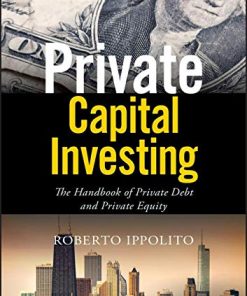eTextbook 978-1118138502 Private Equity: History, Governance, and Operations (Wiley Finance)
$50.00 Original price was: $50.00.$24.50Current price is: $24.50.
eTextbook 978-1118138502 Private Equity: History, Governance, and Operations (Wiley Finance) – Digital Instant Dowload.
eTextbook 978-1118138502 Private Equity: History, Governance, and Operations (Wiley Finance) – Digital Instant Dowload.

Product details:
- ISBN-10 : 1118138503
- ISBN-13 : 978-1118138502
- Author: Harry Cendrowski (Author), Louis W. Petro (Author), James P. Martin (Author), Adam A. Wadecki (Author)
An authoritative guide to understanding the world of private equity (PE) investing, governance structures, and operational assessments of PE portfolio companies
An essential text for any business/finance professional’s library, Private Equity: History, Governance, and Operations, Second Edition begins by presenting historical information regarding the asset class. This information includes historical fundraising and investment levels, returns, correlation of returns to public market indices, and harvest trends. The text subsequently analyzes PE fund and portfolio company governance structures. It also presents ways to improve existing governance structures of these entities. A specific focus on portfolio company operations, including due diligence assessments, concludes the text
Table contents:
Chapter 1. The Private Equity Process.
Introduction.
General Terms And Brief Overview.
Understanding Private Equity.
Private Equity Fund-Raising.
Chapter 2. Characteristics of the Private Equity Arena.
A Brief History Of Private Equity.
Geographical Distribution Of Private Equity Investments.
Historical Private Equity Investment Levels.
Historical Private Equity Returns.
A Nonmainstream Security?
Summary.
Chapter 3. Trends in Private Equity.
Introduction.
Overall Industry Trends.
The Buyout Arena.
The Venture Capital Arena.
Chapter 4. Harvesting Private Equity Investments through IPO.
Initial Public Offerings.
Chapter 5. Harvesting Investments through Mergers and Acquisitions.
M&A Basics.
Types of Takeovers.
Reverse Takeovers.
The Takeover Process and Financial Advisor Selection.
Analyzing Potential Buyers.
The Sale Process.
The Bidding Process.
Reaching an Agreement.
Historical M&A Trends.
MODULE II. Governance Structures in Private Equity.
Chapter 6. The Private Equity Governance Model.
Introduction.
A New Model for Corporate Governance.
Conclusion.
Chapter 7. Value of Internal Control.
Introduction.
Introduction To COSO and Internal Control.
Components Of Internal Control.
Control Objectives and Control Components.
Internal Control And The PE Firm.
Conclusion.
Chapter 8. Internal Control Evaluation.
Introduction.
PCAOB Auditing Standard No. 5.
Phase 1: Planning the Audit.
Phase 2: Using a Top-Down Approach.
Phase 3: Testing Controls.
Phase 4: Evaluating Identified Deficiencies.
Phase 5: Wrapping Up.
Phase 6: Reporting on Internal Controls.
Chapter 9. Financial Statement Fraud and the Investment Decision.
Money Laundering.
Catergories of Fraud.
What is Fraud?
The Required Elements of Fraud.
Financial Statement Attestation.
Recommendations.
Fraud and Due Diligence Procedures.
Conclusions.
Chapter 10. Professional Standards.
Introduction.
Federal Trade Commission (FTC).
Securities and Exchange Commission (SEC).
“Private” Equity Going Public.
PCAOB Standards.
AICPA Auditing Standards.
AICPA Accounting and Review Standards.
Institute of Internal Auditors (IIA) Standards.
Information Systems Audit and Control Association.
Chapter 11. Contemporary Business and Competitive Intelligence.
Introduction.
Contemporary Business Intelligence.
Competitive Intelligence amd The External Environment.
Normalizing Performance.
Cost of Capital and the Option to Invest.
Developing “Idiosyncratic Acumen”.
An Economic View of Quality.
Developing Relationships and Navigating Crises.
Application to Private Equity.
MODULE III. Understanding Operations.
Chapter 12. Organizations as Humans.
Introduction.
Organizations as Humans.
Chapter 13. Beginning the Lean Transformation.
Introduction.
Chapter 14. Manufacturing Due Dilligence: How to Perform Operations Assessments.
Introduction.
Performing the Assessment.
Operational Data and Cost of Sales.
Conclusion.
MODULE IV. Special Considerations in Private Equity Investments.
Chapter 15. Private Equity Fund and Portfolio Company Investment.
Understanding Investors and the Investment Process.
Mezzanine Financing.
Private Equity Investment in Distressed Companies.
Chapter 16. Legal Considerations in Exit Strategies: IPO vs. Sale.
IPO vs. Sale Transaction.
Initial Public Offering (IPO).
Sale Transactions.
Chapter 17. Raising Capital through Exempt Offerings of Securities.
Introduction.
Exemptions from Securities Act Registration.
State Securities (“Blue Sky”) Laws.
Antifraud Provisions.
Broker-Dealer and Agent Registration Exemptions.
Restrictions on Resales of Restricted Securities.
You may also like…
Business & Economics - Personal Finance
Uncategorized
eTextbook 978-0133507676 Fundamentals of Corporate Finance (Pearson Series in Finance)













